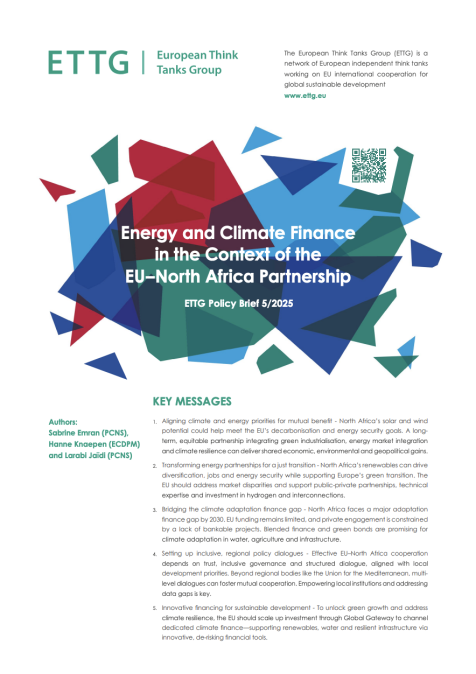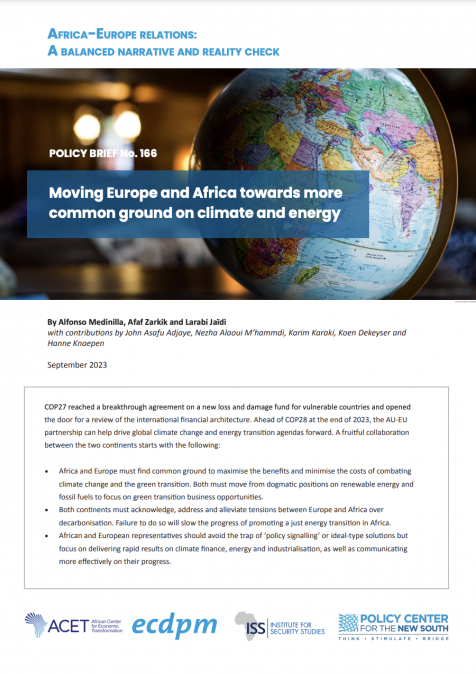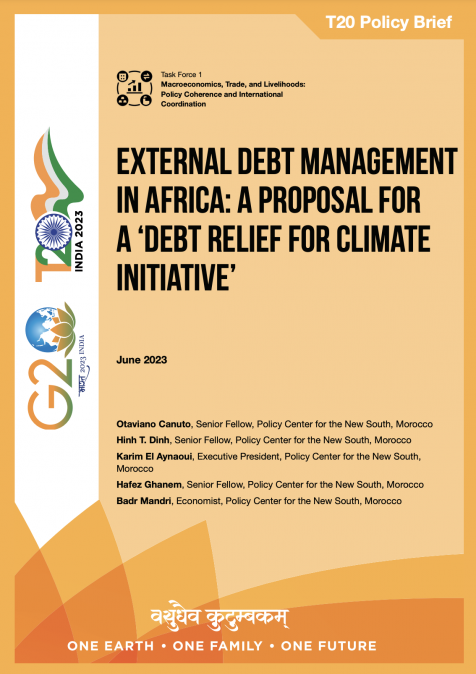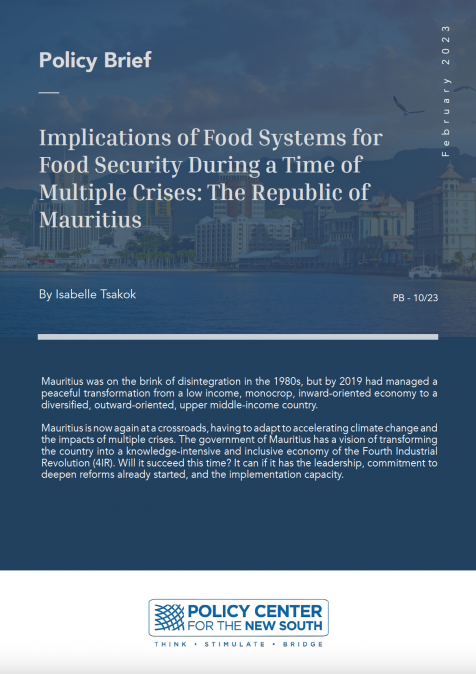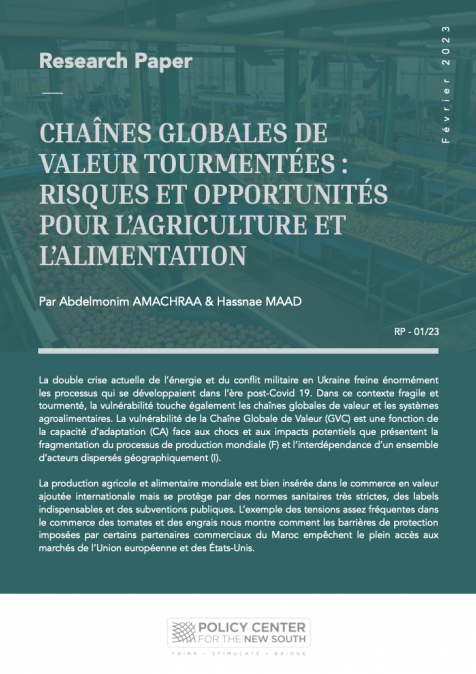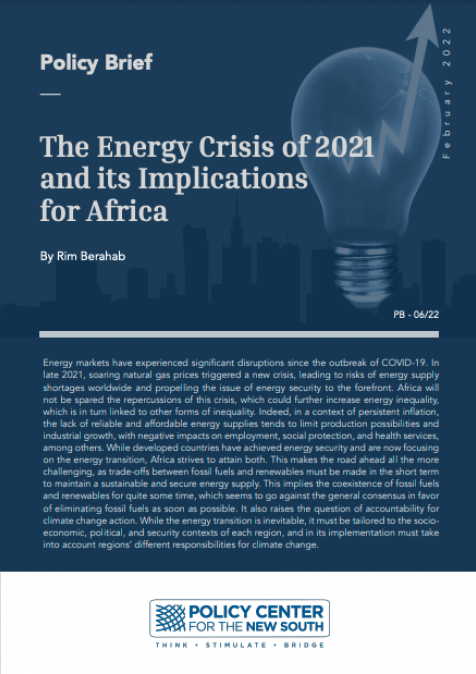Publications /
Policy Brief
This Paper was originally published on ettg.eu
KEY MESSAGES
1. Aligning climate and energy priorities for mutual benefit - North Africa’s solar and wind potential could help meet the EU’s decarbonisation and energy security goals. A longterm, equitable partnership integrating green industrialisation, energy market integration and climate resilience can deliver shared economic, environmental and geopolitical gains.
2. Transforming energy partnerships for a just transition - North Africa’s renewables can drive diversification, jobs and energy security while supporting Europe’s green transition. The EU should address market disparities and support public-private partnerships, technical expertise and investment in hydrogen and interconnections.
3. Bridging the climate adaptation finance gap - North Africa faces a major adaptation finance gap by 2030. EU funding remains limited, and private engagement is constrained by a lack of bankable projects. Blended finance and green bonds are promising for climate adaptation in water, agriculture and infrastructure.
4. Setting up inclusive, regional policy dialogues - Effective EU–North Africa cooperation depends on trust, inclusive governance and structured dialogue, aligned with local development priorities. Beyond regional bodies like the Union for the Mediterranean, multilevel dialogues can foster mutual cooperation. Empowering local institutions and addressing data gaps is key.
5. Innovative financing for sustainable development - To unlock green growth and address climate resilience, the EU should scale up investment through Global Gateway to channel dedicated climate finance—supporting renewables, water and resilient infrastructure via innovative, de-risking financial tools.
INTRODUCTION
The European Union (EU) is seeking to enhance energy security. It clearly recognises North Africa’s strategic role in the global energy transition, given the region’s abundant renewable resources, with some of the world’s highest solar irradiation and strong winds. Joint efforts could advance shared sustainable energy solutions and generate mutual benefits. Climate finance plays a crucial role in facilitating the renewable energy transition. Egypt, Tunisia, Morocco and Algeria are well-positioned to lead this transition, while advancing their own renewable energy sectors, green industrialisation and the hydrogen economy. Through the EU’s Global Gateway AfricaEurope Investment Package (EC, 2025a), various flagship projects have been approved for North Africa since 2023. These include green energy projects in Algeria and Tunisia (MedLink) (Council of the European Union, 2024), a 1.7 GW renewable energy programme in Tunisia in 2024 (Hellenic Aid, 2024) or the construction of a high-voltage undersea electrical interconnection between Egypt and Greece in 2023 (French Ministry of Europe and Foreign Affairs, 2023). However, realising this potential requires significant investment and infrastructure development to ensure a just and sustainable transition that benefits both local economies and global partners.
North Africa faces escalating climate challenges, with rising temperatures and declining rainfall threatening water and food security (Trisos et al., 2022). More frequent heatwaves accelerate desertification, while sea-level rise endangers coastal cities and infrastructure. These challenges exacerbate socio-economic vulnerabilities, migration pressures and regional instability, with potential repercussions for Europe (Desmidt, 2021). Building regional resilience and adaptation measures, including improved water management and climate-resilient agriculture, is essential but faces countryspecific obstacles. Furthermore, the allocation of climate adaptation finance to North Africa remains low, necessitating proactive engagement from the EU, to enhance the region’s climate resilience (Osman, 2024).
The EU’s new strategies, most notably the New Pact for the Mediterranean and the Trans-Mediterranean Energy and Clean Tech Cooperation Initiative, as well as its approach to climate mitigation and adaptation in North Africa, are shaped by the EU’s geostrategic and economic interests:
energy security and migration control. However, the EU’s agenda is criticised for being too extractivist, insufficiently aligning with North African priorities (Haytayan, 2025). Other factors hindering closer EU–North Africa cooperation include a lack of trust in institutional frameworks, shortterm interests and inconsistencies between the EU’s financial pledges for climate and energy and the actual disbursements of funding. Further complicating the landscape are fragmented climate finance mechanisms, data gaps in non-financial climate risks (e.g., seismic and flooding hazards) and growing concerns over European unilateral trade measures like the Carbon Border Adjustment Mechanism. Meanwhile, geopolitical uncertainties—including protectionism, debt burdens, competition over green industrial policies and increasing aid cuts—add further pressure to the partnership.
This brief explores how to effectively address North Africa’s energy and climate adaptation finance gap, reflecting the region’s integral role in shaping a sustainable energy future both for the EU and for North Africa, and advancing common, long-term climate commitments. Effective resource mobilisation will require a recalibrated climate finance approach to achieve two key goals: (1) a mutually beneficial green energy and industrial strategy, and (2) a joint adaptation and resilience agenda. Focusing on Morocco, Tunisia and Egypt, the brief outlines pathways to effectively increase adaptation finance and green energy investments.
North Africa’s proximity positions it as a strategic partner for the EU in developing energy infrastructure, including hydrogen corridors and expanded electrical interconnections across the Mediterranean, thereby reducing reliance on fossil fuels. For North African nations, deeper engagement with the EU in climate and energy sectors can attract investment, technical expertise and technology transfer, leading to job creation, economic diversification, enhanced energy security and increased access to climate adaptation finance.
The EU has developed several policy frameworks to support interconnected Southern Mediterranean energy and industrial geography. The European Green Deal serves as the overarching climate and energy framework, complemented by the EU External Energy Strategy (EC, 2022a) and the renewed Partnership with the Southern Neighbourhood (EC, 2022b). The creation of a dedicated Directorate-General for the Middle East, North Africa and the Gulf (DG MENA, formerly DG NEAR), under Commissioner Dubravka Šuica, underscores the EU’s recognition of the region’s strategic importance. This restructuring aims to enhance policy coherence, shifting from reactive crisis management to a structured, longterm partnership. Commissioner Šuica’s proposed New Pact for the Mediterranean seeks to integrate energy security, economic cooperation and climate resilience into a cohesive, regionally coordinated strategy (Šuica, 2024). A key component of this Pact is the Trans-Mediterranean Energy and Clean Tech Cooperation Initiative, aiming to boost renewable energy trading and enhance clean technology manufacturing across the Mediterranean region through the EU’s Global Gateway (Governatori, 2025).
Progress has been made in practical interconnections. North African nations are positioning themselves as players in green hydrogen development. In 2022, Morocco and the EU signed the Morocco-EU Green Partnership, leading to a forum on green hydrogen regulation in Rabat, aligning Morocco’s advancements with Europe’s energy needs. In 2024, Morocco launched the ‘Offre Maroc’ strategy to promote green hydrogen production and export. Similarly, Egypt’s ‘Green Hydrogen’ project secured a nearly €400 million contract through the inaugural H2Global auction, committing to supply renewable ammonia to Europe until 2033 (Egypt Independent, 2024).
The 2025 Work Programme of the new European Commission reflects a shift toward a pragmatic focus on industrial competitiveness, economic stability, job creation and energy security, driven by global instability concerns (EC, 2025b). Central to this strategy is the Competitiveness Compass, introduced in January 2025, which serves as a strategic roadmap to restore Europe’s dynamism and enhance economic growth (EC, 2025c). The Competitiveness Compass outlines three core areas for action: innovation, decarbonisation, and increased security and resilience. It also emphasises five cross-cutting activities to underpin these actions, including simplifying administrative burdens on businesses and lowering barriers to the Single Market. While the EU’s focus on competitiveness and internal priorities is crucial, it presents opportunities for enhanced collaboration with North Africa, where joint initiatives can support mutual goals in sustainable development and economic growth.
Integrating North Africa into Europe’s green energy network offers a strategic pathway to decarbonise the steel industry (Karkare & Medinilla, 2024). By importing hydrogenderived hot-briquetted iron from North Africa, Europe can complement domestic steel decarbonisation efforts, enhancing competitiveness and fostering regional synergies. This balanced approach supports the European Green Deal’s objectives by reimagining industrial partnerships and scaling global markets for green industrial products.
In terms of policy support for climate adaptation and resilience building, the European Commission’s agenda for the Southern Neighbourhood (2021) highlights the green transition and climate action as priorities integral to the region’s resilient post-pandemic recovery (EC, 2021). The European Neighbourhood Policy has facilitated financing for numerous climate resilience projects. Additionally, the Union for the Mediterranean—comprising the 27 EU member states and 15 partner countries from the Mediterranean basin—has demonstrated political will to establish a more coordinated approach to climate resilience (Abdullah et al., 2021).
Despite ambitious goals and a clear strategic rationale for stronger EU–North Africa partnerships, the scale of financing remains insufficient to effectively address energy and climate adaptation challenges. It is crucial to translate ambitions into a coherent and ambitious finance agenda to avoid empty promises or the instrumentalisation of North African countries without yielding substantial economic development outcomes.
LIMITED ENERGY & CLIMATE ADAPTATION FINANCE
Current landscape of energy finance
North Africa’s diverse economies and political landscapes require tailored energy transition strategies, coordinated to ensure equitable benefit distribution. In Morocco, for instance, debates focus on balancing renewable energy exports, desalination projects and cultivation of waterintensive crops like watermelons, amid groundwater depletion concerns. These trade-offs underscore the need for comprehensive governance frameworks that harmonise national interests with regional cooperation, ensuring environmental sustainability and social equity.
A growing concern across the North African region is whether the benefits of the green transition will be equitably distributed, particularly given disparities in market readiness and industrial competitiveness. The EU’s Carbon Border Adjustment Mechanism is widely perceived as a policy that primarily serves European interests, raising concerns over its impact on North African economies that rely on energyintensive exports. While leading nations in the energy transition capitalise on job creation and technological advancement, North Africa continues to lag in renewable energy integration, missing out on the economic spillovers associated with clean energy investment (Berahab, 2023).
At the heart of these challenges is the climate finance market, which remains constrained by its relatively limited size, especially in relation to the scale of investments required to attract institutional capital. This is particularly problematic for large-scale energy projects, which demand long-term financing structures that many African markets struggle to provide. Overall, the region faces a significant mismatch between the financial needs of its energy sector and the actual funds received to support its energy transition, with climate finance in Africa overwhelmingly dominated by debt instruments that often come with restrictive terms and high borrowing costs. This financial asymmetry exacerbates the continent’s difficulties in accelerating its energy transition, reinforcing structural barriers to low-carbon growth.
The TeraMED Initiative, uniting North Africa to South Europe, aims to install 1 terawatt of renewable energy capacity in the Mediterranean region by 2030, enhancing energy security, affordability, clean industrial development, job creation and investment opportunities (Governatori, 2025). This initiative seems to counter the general tendency of European investments in North African renewable energy projects, particularly in hydrogen and ammonia, which have primarily been export-oriented and have yet to reach critical mass despite their strategic potential. Countries like Morocco and Mauritania possess exceptional renewable energy resources, with high solar photovoltaic load factors and efficient wind power. However, their hydrogen projects represent only a small fraction of the global pipeline and face slower development timelines toward final investment decisions (Rikabi, 2024).
North Africa’s proximity to Europe offers a logistical advantage for hydrogen exports via cost-effective pipelines. However, higher capital costs in these developing markets increase production expenses by approximately 25% compared to European counterparts (Vejgaard et al., 2024). Despite the EU’s Hydrogen Strategy aiming to establish credible demand signals, the gap between ambition and implementation persists. To capitalise on renewable potential and expedite hydrogen project development, North Africa requires targeted investment incentives and robust policy frameworks (Agora Industry, 2024).
Current landscape of climate adaptation finance
Despite a well-defined policy framework for adaptation and resilience, North African countries face a significant and growing adaptation finance gap, with a projected collective $89.3 billion gap in Morocco, Tunisia and Egypt by 2030 (Osman, 2024; Climate Policy Initiative, 2024). This shortfall threatens socio-economic transformation across various sectors, notably the water and agri-food sectors, and should be a central concern in all climate and development finance programmes within the region. Bridging this gap will require mobilising both public and private resources.
North African countries are implementing climate adaptation policies. Morocco has integrated adaptation into national frameworks, including the Policy on Climate Change, the National Water Strategy and the “Generation Green Plan” (2020–2030), emphasising innovation, green technology and resilient agriculture (Ministry of Agriculture, 2020). Its National Adaptation Plan (NAP) outlines priority sectors, actions and financing needs up to 2030 (UNFCCC, 2022). Egypt’s National Climate Change Strategy 2050 prioritises adaptation, with measures like water conservation techniques to preserve arable land (Abdelaty et al., 2023). Egypt has also updated its Nationally Determined Contribution (NDC), detailing planned adaptation actions. Tunisia’s NDC outlines its adaptation needs and strategies, though a comprehensive NAP is pending. Algeria’s National Adaptation Strategy, on the other hand, integrates climate change adaptation into sectoral development plans to protect populations and infrastructure from climate risks (UNDP, 2023). Priority sectors include agriculture, water resources, health, public works and transport, focusing on energy efficiency and renewable energy production. While Algeria’s NDC outlines relatively undetailed adaptation priorities compared to mitigation, it categorises proposed activities by technology type, with a focus on enhancing institutional and human capacities, early warning systems and localised adaptation plans.
Despite the aforementioned EU policy commitment to climate adaptation and resilience, support for North African countries remains limited. Between 2010 and 2021, EU institutions (excluding the European Investment Bank) disbursed less than €200 million for climate adaptation in the entire Middle East and North Africa region (SEI, 2023). Moreover, while the EU has pledged further support, adaptation finance is unlikely to increase due to shifting geopolitical priorities and budgetary constraints (Knaepen, 2025).
Currently, public domestic funding primarily supports climate adaptation initiatives in North Africa. However, limited fiscal capacity and escalating debt levels highlight the necessity for greater private sector engagement and innovative financial tools to attract private capital, including from Europe (African Development Bank, 2023). North African financial authorities are already developing comprehensive roadmaps that prioritise climate agendas. These plans not only focus on financial instruments for adaptation and mitigation but also address the financial risks associated with climate finance for central banks, defining their roles in providing essential liquidity and ensuring macroeconomic stability during transitions. However, despite these efforts, a shortage of bankable projects and perceived investment risks continue to deter private capital from engaging in adaptation initiatives (ISPI, ORF & PCNS, 2023).
SOLUTIONS THROUGH POLICY, FINANCE AND DIALOGUE
The partnership between the EU and North Africa would present a unique model for North-South cooperation in addressing climate change and energy transition challenges. To move beyond short-term crisis management (i.e., migration agendas) and extractivist approaches, both regions must adopt a long-term strategic vision of dependencies. Strengthening trust and establishing a shared vision is essential for advancing cooperation, particularly in energy market integration and climate finance. To enhance collaboration in climate adaptation and financing energy transition, the following three entry points are proposed:
1. Identifying common interests on the climate adaptation and energy agendas - whether related to development, geostrategic or (geo)economic interests - while acknowledging differing capacities and perspectives.
2. Increasing climate adaptation and energy finance, while ensuring accessible and innovative funding mechanisms tailored to North African contexts.
3. Establishing structured, inclusive, and multi-level dialogue between the EU and groups of North African countries - potentially through forms of ‘mini-lateralism’ - to better align energy and climate policies across both regions.
By focusing on these areas, the EU and North Africa can develop a strategic partnership that effectively addresses shared climate and energy challenges.
1. Identify common interests
Developing robust regional frameworks to coordinate climate finance and integrate energy markets across North Africa can streamline funding processes and promote efficient resource use. By capitalising on abundant renewable resources like solar and wind power, North Africa can meet local energy demands and contribute to Europe’s energy needs, fostering mutual energy security and supporting the global transition to sustainable energy. The decarbonisation of Europe’s energy system necessitates a reconfiguration of industrial production, presenting immediate opportunities in sectors like green hydrogen, steel and fertilisers. This collaborative approach necessitates a shift from short-term crisis management to long-term strategic partnerships that respect the sovereignty and priorities of North African countries. Prioritising a bottomup approach can promote strategies tailored to address specific national contexts (thus helping build mutually beneficial partnerships), acknowledging the region’s diverse socio-economic landscapes.
The EU–North Africa energy partnership could be framed within the EU-led Trans-Mediterranean Energy and Clean Tech Cooperation Initiative, which seeks to strengthen collaboration on renewables and clean tech across Europe, North Africa and the Middle East. In this context, trade measures like the Carbon Border Adjustment Mechanism— criticised by some North African partners—should be balanced with targeted, ambitious investments in green energy-intensive industries.
To effectively enhance climate finance in North Africa, it is essential to develop innovative strategies that attract both private and public investments for climate adaptation and mitigation. While climate mitigation enjoys significant political support—aligning with the EU’s strategic goals for energy autonomy and benefiting from established market dynamics with clearer investment returns—climate adaptation must also remain a priority. Emphasising its co-benefits, such as linking climate action with job creation, health improvements and infrastructure development, ensures its continued prominence on the agenda. Moreover, exploring synergies between climate-related policies and other sectors, including migration, employment and industry, can lead to more comprehensive and sustainable outcomes. Crucially, achieving these goals requires aligning the climate policies of the partners and ensuring that climate finance objectives are in harmony with development priorities. This dual alignment strategy not only meets local needs but also fosters a balanced partnership, benefiting both North Africa and the EU through focused, sustainable investments.
As regions increasingly adopt protective measures like tariffs and subsidies, looking outward and fostering strategic interdependencies may be less risky than inward-focused approaches. European strategic autonomy requires more than supply chain security; it involves designing diverse and strategic interdependencies.
2. Increase financial commitment through innovation
North Africa stands at a critical juncture in its pursuit of green energy transition and fight against climate change, with innovative financing mechanisms emerging as key enablers of change. The region has seen significant developments in blended finance solutions, as highlighted by Morocco’s Noor Ouarzazate Solar Complex. This landmark project, spanning 3,000 hectares and generating 580 megawatts of power, was structured as a public-private partnership between the Moroccan Agency for Sustainable Energy (MASEN) and a consortium led by ACWA Power, a Saudi Arabian developer (WorldBank, 2018). The project mobilised $3.2 billion through concessional financing from multilateral development banks and then provided it to the private consortium at commercial terms, effectively creating a risk shield for private investors (African Development Bank, 2019). Moreover, the establishment of Egypt’s $2 billion sovereign green fund in 2023 and Morocco’s engagement in green financing mechanisms such as green bonds have strengthened the financial infrastructure (Green Climate Fund, 2023).
Egypt has similarly entered the green bonds market, raising $750 million in 2020 as the region’s first sovereign green bond with a five-year term and a 5.25% yield, making it the first country in the region to do so. The bond proceeds were earmarked for eligible green projects, including clean transportation initiatives, renewable energy projects and sustainable water management systems (Samak, 2021). The success of this initial issuance paved the way for Egypt’s subsequent green financing initiatives, including the establishment of a comprehensive green financing framework aligned with International Capital Market Association principles.
To bolster investor confidence in climate adaptation projects, it is essential to enhance regulatory frameworks, promote innovative financing mechanisms such as blended finance and de-risk investments through guarantees and concessional financing. Demonstrating the profitability of these initiatives and fostering collaboration among governments, financial institutions and project developers is crucial. Additionally, targeted capacity-building initiatives can empower local stakeholders to design bankable projects that align with global climate funds and institutional investors’ criteria (Ahairwe & Bilal, 2023. This collaborative approach— encompassing public-private partnerships, derisking instruments and regionally coordinated policy frameworks—can unlock North Africa’s renewable energy potential and ensure a just, inclusive energy transition, while building climate resilience.
To enhance EU–North Africa cooperation, it is essential to identify sectors with high investment potential, such as renewable energy, sustainable agriculture or water management. Specifically, the creation of a new dedicated Global Gateway Project focused on generating co-benefits from climate adaptation and green transition in the Southern Neighbourhood could ensure a more coordinated and impactful deployment of climate finance resources. By pooling resources from EU institutions such as the European Commission, the European Investment Bank and other European Development Finance Institutes, and leveraging blended finance mechanisms, the initiative could attract additional private investment while ensuring sustainable, long-term funding. It could focus on critical sectors, including water security, agricultural resilience, coastal protection, green energy and urban adaptation, directly supporting NDCs and NAPs through technical assistance, capacity building and knowledge-sharing platforms. At the same time, integrating funding mechanisms that simultaneously address green transition, climate adaptation and economic development in North Africa is crucial. This holistic approach acknowledges that climate action aligns with sustainable development goals. Given the broader climate risks facing the region—beyond water scarcity to include desertification, extreme weather and agricultural sustainability—a comprehensive, multisectoral approach is essential (UNEP-FI, 2022).
The economics of renewable power and hydrogen projects are critically constrained by the prohibitive cost of capital, particularly in emerging markets with perceived investment risks. While politically stable, resource-rich countries like Mauritania or Egypt have promising renewable energy potential, they face substantial financial headwinds that dramatically increase project financing expenses. The renewablerich regions may increasingly attract energy-intensive decarbonisation opportunities, but the reality of elevated risk premiums creates significant barriers to entry. In Mauritania, for instance, the cost of capital can be egregiously high, effectively neutralising the competitive advantages of abundant solar and wind resources. Both Mauritania and Egypt experience markedly higher financing costs compared to more developed markets, with investors demanding substantial risk compensation. This financing challenge underscores the critical importance of managing distributional effects across countries and fostering equitable partnerships that can help mitigate perceived investment risks.
3. Setting up inclusive dialogue
Advancing energy and climate collaboration in North Africa requires inclusive regional policy dialogues that foster equitable partnerships and leverage existing initiatives. However, regional cooperation is hampered by the persistence of barriers to regional integration and unified political interests (Knaepen, 2024). Organisations like the Union du Maghreb Arabe (UMA) and the Union for the Mediterranean were established to address these challenges but have struggled to make significant progress. Yet, the Union for the Mediterranean may hold the potential to be a collaborative platform among North African nations, European partners and stakeholders from the Global South to harmonise policies, share best practices and develop collaborative approaches on the energy and climate adaptation agendas.
Regular, inclusive and multilevel dialogues can facilitate transparent discussions, ensuring that climate finance aligns with local development and socio-economic priorities. Fundamentally, bilateral investments and trade—as seen in the Elmed Interconnector and EU gas supply diversification efforts—will remain central to EU–North Africa relations. However, to foster mutually beneficial partnerships and shared responsibility, inclusive dialogue is essential. Moreover, stronger regional coordination is critical to avoid fragmentation and counterproductive export competition, especially in strategic emerging sectors like green hydrogen. Effective climate finance hinges on locally driven solutions that incorporate traditional knowledge and address specific community needs (Cities Alliance, 2024). Supporting locally led initiatives and establishing shared learning platforms can enhance cooperation at both bilateral and regional levels. Strengthening local institutions’ capacities in financial planning and project implementation is essential for empowering them to design and execute successful climate projects. Engaging stakeholders across various governance levels ensures that energy and climate finance objectives align with local development priorities. This comprehensive approach fosters tailored strategies that integrate local needs into innovative financial instruments, facilitating accessible and effective grassroots funding.
IN CONCLUSION
1. EFFECTIVE EU–NORTH AFRICA COOPERATION ON ENERGY AND CLIMATE DEMANDS TRUST, INCLUSIVE GOVERNANCE AND MEANINGFUL DIALOGUE. The establishment of a dedicated DG MENA offers an opportunity to reshape institutional frameworks, deepen regional collaboration and provide a foundation for more coherent and locally responsive policy development. Success hinges on state leadership and the agency of local actors: North African governments must prioritise public finance for their green transition and to build climate resilience while having to face increasing debt challenges; the EU must increase energy and climate adaptation investments, while financial institutions should tailor criteria to support small-scale projects and aggregate them into investable portfolios. Innovative financial products, such as blended finance and green bonds, can attract private sector engagement, to meet both renewable energy and climate adaptation needs.
2. BOTH THE EU AND NORTH AFRICA SHOULD VIEW ECONOMIC DEVELOPMENT AND CLIMATE FINANCE AS COMPLEMENTARY RATHER THAN COMPETING PRIORITIES. Integrating these financial streams can create synergies that advance both objectives. To maximise the effectiveness of allocated resources, it is essential to strengthen local capacities. Addressing gaps in climate data collection and analysis is also crucial, particularly concerning non-financial risks like flooding hazards. Enhancing technical capabilities among non-profit organisations and small businesses will better position them to meet funding requirements and implement effective climate adaptation strategies.
3. TO STRENGTHEN EU–NORTH AFRICA ENERGY AND CLIMATE COOPERATION, IT IS ESSENTIAL TO ACKNOWLEDGE EACH REGION’S UNIQUE NEEDS AND WHAT IS HAS TO OFFER. Harmonising international and domestic financial standards, streamlining environmental, social and governance reporting, and enhancing regional bargaining power through improved risk monitoring and data strategies are crucial steps. Success depends on sustained commitment to capacity building, technology transfer and developing energy and climate finance mechanisms that are ambitious yet grounded in local realities, ensuring a just transition. Without such a comprehensive approach, transformative cooperation may remain unrealised, hindering both regions’ ability to achieve a mutually beneficial energy and climate partnership.
BIBLIOGRAPHY
Abdelaty, H., Weiss, D., & Mangelkramer, D. (2023). Climate policy in developing countries: Analysis of climate mitigation and adaptation measures in Egypt. Sustainability, 15(11): 9121. https://www.mdpi.com/2071-1050/15/11/9121
Abdullah, H., Elgendy, K., & Knaepen, H. (2021). Climate resilience in cities of the EU’s Southern Neighbourhood: Opportunities for the EU Green Deal. Research Paper CASCADES. https://www.cascades.eu/publication/climate-resilience-in-cities-of-the-eus-southernneighbourhood-opportunities-for-the-eu-green-deal/
African Development Bank. (2019). Ouarzazate solar complex project: Phase II (Noor II and Noor III power plants). https://www.afdb.org/en/projects-operations/selected-projects/noor-ouarzazate-solarcomplex-project-phase-ii-noor-ii-and-iii-power-plants
African Development Bank. (2023). Africa: Climate finance facing global macroeconomic challenges; time for private sector support. https://www.afdb.org/en/news-and-events/africa-climate-financefacing-global-macroeconomic-challenges-time-private-sectorsupport-60566
Agora Industry. (2024). Industrial value chain transformation. Renewable hydrogen as an enabler of a just global energy transition. https://www.agora-industry.org/publications/industrial-value-chaintransformation
Ahairwe, P., & Bilal, S. (2023). Mobilising (European) development finance for climate adaptation and resilience. https://www.cascades.eu/publication/mobilising-european-development-finance-forclimate-adaptation-and-resilience/
Berahab, R. (2023). Navigating the CBAM transitional period: Understanding the latest developments, and enhancing preparedness. Policy Brief. Policy Center for the New South (PCNS). https://www.policycenter.ma/sites/default/files/2023-07/PB_29_23%20%28Rim%20Berahab%29.pdf
Cities Alliance. (2024). Back to the future: Heritage-based solutions for climate resilience in MENA cities. https://www.citiesalliance.org/resources/publications/publications/back-future-heritage-basedsolutions-climate-resilience-mena
Samak. (2021). Egyptian sovereign green funds. https://www.sbfnetwork.org/wp-content/assets/policy-library/692_Egypt_Egyptian_Sovereign_Green_Bonds.pdf
SEI. (2023). Aid atlas. https://www.sei.org/tools/aid-atlas/
Šuica, D. (2024). Mission letter of Commissioner-designate for the Mediterranean, to U. von der Leyen - President of the EC. European Commission. https://commission.europa.eu/document/download/24039223-f92e-40a0-a440-a27d9715051a_en?filename=Mission+letter+%C5%A0uica.pdf
Trisos, C. H., Adelekan, I. O., Totin, E., Ayanlade, A., Efitre, J., Gemeda, A., Kalaba, K., Lennard, C., Masao, C., Mgaya, Y., et al. (2022). Africa. In: Climate change 2022: Impacts, adaptation and vulnerability. Contribution of Working Group II to the Sixth Assessment Report of the Intergovernmental Panel on Climate Change [H.-O. Pörtner, D.C. Roberts, M. Tignor, E.S. Poloczanska, K. Mintenbeck, A. Alegría, M. Craig, S. Langsdorf, S. Löschke, V. Möller, A. Okem, B. Rama (eds.)]. Cambridge University Press, Cambridge, UK and New York, NY, USA, pp. 1285–1455. https://www.ipcc.ch/report/ar6/wg2/chapter/chapter-9/?utm_source=chatgpt.com
UNDP. (2023). Advancing the National Adaptation Plan process in Algeria to address short- and medium-term adaptation needs and lay the ground for long-term adaptation. https://www.adaptation-undp.org/projects/naps-gcf-algeria
UNEP-FI. (2022). Scaling private sector climate finance in the MENA region. UN Environment Programme - Finance Initiative. https://www.unepfi.org/themes/climate-change/scaling-private-sector-climatefinance-in-the-mena-region/
UNFCCC. (2022). Morocco National Adaptation Plan 2022-2030. https://unfccc.int/documents/636730
World Bank. (2018). Morocco: Ouarzazate concentrated solar power project. https://documents.worldbank.org/en/publication/documents-reports/documentdetail/503371525382384008/moroccoouarzazate-concentrated-solar-power-project
Vejgaard, S. R., Kronborg, A., & Lausten, N. L. (2024). Unlocking the potential of African-European green hydrogen trade. Copenhagen Economics. https://copenhageneconomics.com/insight/unlockingthe-potential-of-african-european-green-hydrogen/

